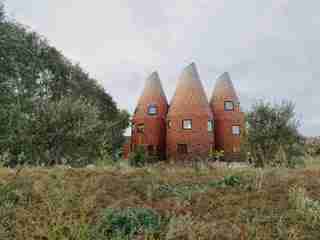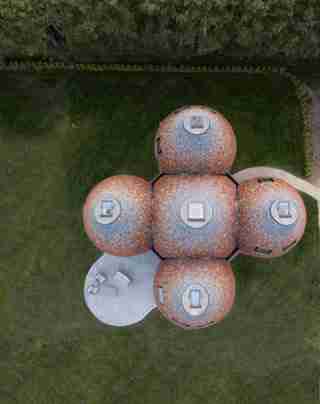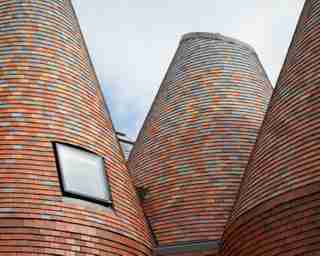At its best, great architecture can maintain your attention. Yet to create a world-class structure, the architect must push the medium by doing something bold, different. This difficult act of making space isn't always successful . In fact, the U.K. has an annual architecture prize, the Carbuncle Cup, for the ugliest building in the United Kingdom completed that year. The architects at ACME have nothing to worry about with their recent design of Bumpers Oast, a radically different approach to a family country house. The home—which was named for its similarity in design to hop kilns, buildings designed for the drying of hops during the beer-brewing process—is made up of four towers, each featuring exaggerated ceilings in the shape of a cone.
"We reimagined the traditional oast house to create a 21st-century home for a family with two young children," says Lucy Moroney, architect at the London-based firm ACME. "The client was very open to pushing the boundaries of designing an innovative house, with a focus on employing the local skills and trades of traditional buildings in Kent."
Tour this remarkable, neo-futuristic home below.

“The process of construction was very pushing to manifest a design which was a contemporary interpretation of the traditional oast,” explains ACME architect Lucy Moroney. “Although the house is highly bespoke, we developed simple and clean details, which worked with the nature of the geometry.”

An aerial view shows the symmetrical design of each unit within the home. While traditional oast houses maintained a little space between each one, the architects opted for a more unified structure.

“Kent-style tiles in eight shades have been used to create the exterior skin, slowly fading from dark red at the base to orange in the center and blue toward the sky,” says Moroney. While the scheme was designed by ACME, the architects leaned on the experience of locals in building the structure: “Laying the tiles relied heavily on local craft skills to create smooth transitions from rectangular tiles for the cylinders to increasingly tapering tiles for the cones.”
Over 41,000 tiles clad the walls and roof of the house. "The aim of the use of colors in the project was to be harmonious with the environment," explains Moroney. As such, the firm used a glazed finish with a mix of tiles. "Each tile was treated with an engobe finish.” Engobe is a liquid mixture of clay and other materials suspended in water which is common in ceramics.
The interior space is well lit with natural lighting, a feature the architects were insistent on getting right. “The quality of interior light was an important consideration,” explains Moroney. “And it was made possible by orientating the windows away from the north façade.” It's typically best for the windows of a home to face south, as it's easiest to shade glass during the summer and let sun shine in during the winter.
“Much of the interior is clad in birch plywood, using larger panels at the base and gradually fading to a finer grain as the rows spiral up to the apex,” says Moroney.
A look inside one of the bathrooms of the home.
The conical bedroom on the top floor features walls covered in plywood shingles.
